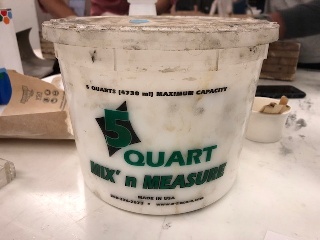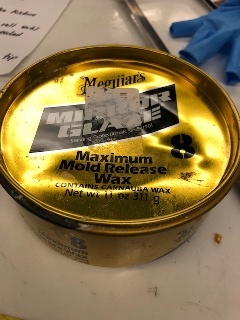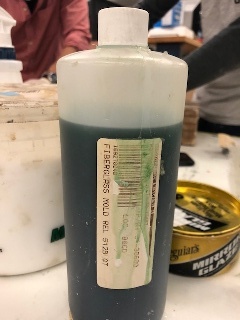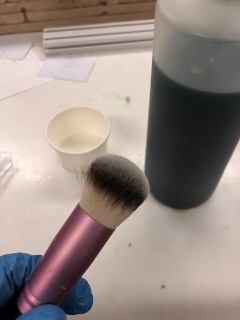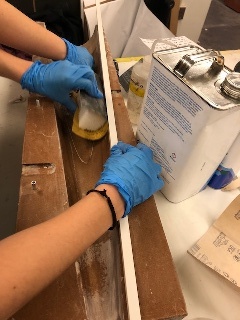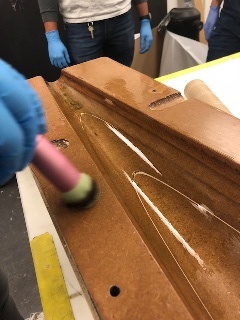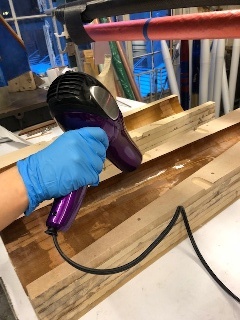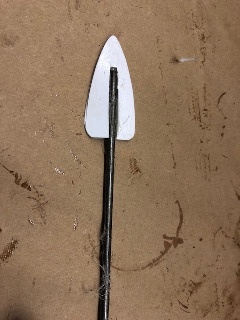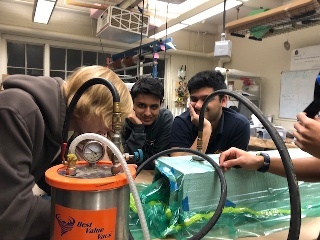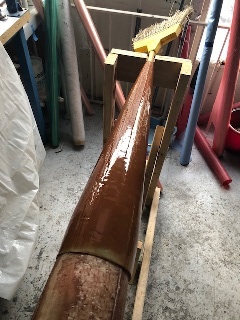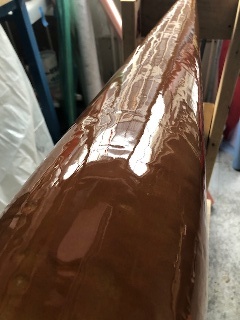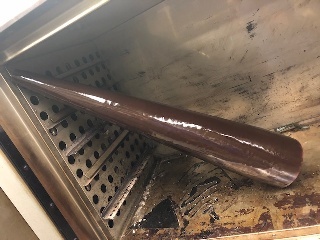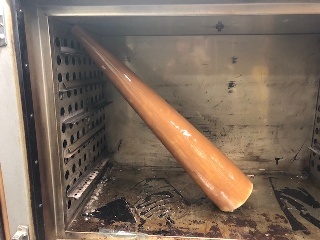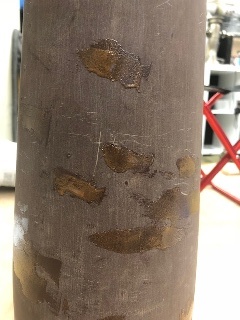Required Materials
- 60-2000 grit sandpaper
- Spray bottle with water
- Shop towels
- System 3000 resin + hardener
- Phenolic microballoons
- Vacuum bagging materials
- Vacuum bag
- Vacuum tape
- Release film
- Peel ply
- Bleeder fabric
- Cabosil (fumed silica)
- Long rod
- Layup jig
- Mold release wax
- Parchment or wax paper
- PVA film
- Mallet
- Popsicle sticks
- Fine-haired brush (This is for applying the PVA film to the mold for mold release. I used a makeup brush, which worked pretty well)
- Heat gun
- Sharp scissors
- Spray glue (Super77, made by 3M)
Below are pictures of some of the materials used (from left to right: cabosil, mold release wax, PVA film, fine-haired brush)
Manufacturing Procedure
Mold Preparation
- Wet sand mold to 2000 grit using sanding block (made of foam)
- MAKE SURE TO PROTECT EDGES with some flat piece of aluminum or other rigid material, or you'll get a lip on the seam in the end that you need to sand
- Wax mold (3 layers of Mold Release Wax, yellow container). For each layer of wax,
- Get a dab of wax on a shop towel and start applying to the mold (top and inside and on either end for good measure)
- Rub in circles until you can't see streaks anymore and there is no more resistance (this is called "buffing")
- Let set for 15 minutes in between coats
- Apply PVA film with fine-haired brush, let set for 20 minutes
Layup Preparation
- Make a template: Make cutout by laying piece of fiberglass in mold and marking the edges, allowing for a 1" tab that decreases to around 0.5" as you get to the tip
- Be sure to mark where the tab is on the cutout so you know how to orient the ply during the layup.
- Using spray glue (3M Super77), lightly spray a piece of wax or parchment paper and, with the help of another person, lay down the ply.
- Smooth out any bubbles/wrinkles (start over if it isn't completely smooth)
- Cut using sharp scissors or pizza-roller type cutting tool on a plastic mat
Layup
- Clear surface and prepare supplies. Cover surface with Mylar because you're going to pour epoxy on it
- Scale for weighing epoxy
- Squeegees
- Shop towels
- Scissors
- Rollers
- Mix cabosil + epoxy and apply to mold (thick on edges)
- Use System 3000 epoxy
- Mix enough cabosil until the texture is like melted butter
- Using a roller, apply to the mold (apply thick coating on the edges in particular)
- Lay down first ply and, using a roller, roll the surface from end to end so that the cabosil + epoxy layer from underneath soaks in
- Pour a generous amount of epoxy in the middle of the table and roll the rollers in it, and apply to the first layer until thoroughly soaked
- Cut any stray fibers in the meantime, but don't wipe away the epoxy on the edges/top of the mold with acetone or you'll remove the PVA film.
- Place a second dry layer, offsetting by around 0.1" as shown below. This is so that when the two halves are put together, there isn't as large of a seam.
- Tab at least 1" at base, shorter at tip
- Attach halves of mold carefully, making sure tab doesn't get stuck
Left of image: seam design for Nose Cone #1. Right of image: new, improved seam design for flight nose cone. Instead of the seam being 20 layers thick (left), it is now only 10 layers thick. While it may be difficult to get the layers perfectly overlapped in practice, the seam should still be a lot less thick. This is good because you won't have to sand the inside of the nose cone as much to fit the coupler inside.
Vacuum Bagging and Mold Release
- Vacuum bag
- Cut bag in cone shape
- Press vacuum bag firmly on edges to make sure there are no gaps, as this will cause bubbles later
- Use "spear tool" (long, thin rod) to push vacuum bag through mold
- Mold release: use chiseled popsicle sticks and hammer (add more until pops open)
Applying Ablative Coating
- Apply ablative (using layup jig)
- Set up layup jig (looks like a spit with a pole running across it that can be rotated by hand)
- Put old nose cone or some coupler inside the nose cone and put both over the pole. The coupler or whatever you can find to fit inside the nose cone gives you something to grab onto so you can turn it after you apply the ablative.
- Mix 100g Systems 3000 resin + 18g Systems 3000 hardener + 17g phenolic microballoons
- Use heat gun to dry (don't overwork)
Oven Cure
- Oven cure
- Wearing gloves, move the nose cone to the oven.
- Position nose cone carefully such that the surface is not touching the oven, as shown below.
- Follow cure cycle for System 3000 epoxy. The color of the epoxy will change from light brown to dark brown/cherry red, as shown below.
Sanding/Filling in Low Spots
- Sand outside
- Sand inside (seam)
- Plane ends
- Fill low spots with ablative + epoxy mixture
- Sand with 60 grit to roughen up because epoxy doesn't stick well to itself. You might have to use a file to get to smaller low spots
- Wipe down surface of nose cone with acetone
- Mix 10g resin + 1.8g hardener (System 3000) + arbitrary amount of phenolic microballoons (just eyeball it until it's about the same consistency as the mixture you made for the ablative coating)
- Carefully apply mixture to low spots, scraping off excess
- Let cure for at least 24 hours and sand
Holes for Coupler
Finishing
- Paint
Lessons Learned:
- Don't coat the mold multiple times with epoxy - just once, let soak and WIPE, then cure and sand
- Protect edges with aluminum or something rigid and straight to prevent them from getting rounded
- Do not wipe mold with acetone once PVA film has been applied or it will come off
